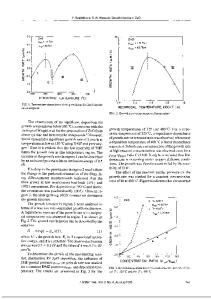Kinetics of Copper Chemical Vapour Deposition from Cu(hfac)VTMS
- PDF / 330,842 Bytes
- 6 Pages / 391.5 x 607.5 pts Page_size
- 76 Downloads / 325 Views
This precursor reacts according to 2 Cu(hfac)VTMS (g)
Cu (s)+ Cu(hfac)2 (g) + 2 VTMS (g)
(1)
already forming a conductive copper layer at a temperature of 120 'C [7]. This low deposition temperature allows one to copper plastics by CVD. With Cu(hfac)VTMS not only substrates like TiN, Si, or Si0 2 can be coppered, but also low-melting materials like polyimide (PI) and polyetherimide (PEI). Metallised plastics are applied in several products like car grilles or computer housings, but also in more sophisticated applications such as Printed Circuit Boards or Moulded Interconnection Devices. In 1995 the project "Functional Metallic Coatings on Plastics" was started in the Netherlands in the framework of the Innovation Directed Research Programme for Surface Technology (IOP-OT). This programme is financed by the Netherlands Ministry for Economic Affairs. The most important goal of this project, to prepare better seed-layers for galvanic metallisation, is aimed for by CVD of copper onto plastics [8]. In order to understand this CVD process better, the present study is performed.
" To whom correspondence
should be addressed. e-mail: [email protected]
149 Mat. Res. Soc. Symp. Proc. Vol. 555 c 1999 Materials Research Society
The copper growth-rate in thermal CVD is monitored in this research. By changing several reaction parameters, insight is gained into the kinetic behaviour of this growth process. A model, recently developed in our group [9], is applied to describe our results. In contrast with conventional models, such as the Langmuir and Langmuir-Hinshelwood-types [10], our model does not involve equilibria and reactions between surface species, but has irreversible reactions between gas and surface only. Based on this model, we will propose a reaction mechanism which describes our experiments satisfactorily, and in a more convenient way than is possible with Langmuir-type models. EXPERIMENT The growth-rates are measured using a microbalance system described previously [1 ].
Several changes in this system were made, because less extreme experimental conditions are needed here. Pressures down to 4 Torr are achieved, while the reactor is operated at temperatures between 110 and 500 0C. The gas delivery system comprises an evaporator system containing Cu(hfac)VTMS kept at 45 'C (PCu(hfac)vrs = 0.5 Torr [12]). In all cases nitrogen is used as an inert carrier gas at flowrates of 0-100 sccm. Deliberate changes in this rate are compensated for in a separate nitrogen line (flow range 0-100 sccm), in order to maintain a constant flow and pressure in the reactor system. Both gas flows, as well as the reactant gas H2 (flow range 0-1000 sccm) and the diluent gas N 2 (flow range 0-1000 sccm) are adjusted and monitored by mass flow controllers. The diluent gas is also used to purge the microbalance and to protect it from unwanted deposition. Due to a by-pass around the evaporator system, the reactor and its feeding lines can be purged, the flows adjusted, and the reactor heated and pressurised before the precur
Data Loading...









